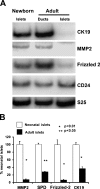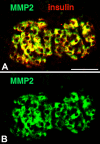Identification of markers for newly formed beta-cells in the perinatal period: a time of recognized beta-cell immaturity
- PMID: 20051380
- PMCID: PMC2842599
- DOI: 10.1369/jhc.2009.954909
Identification of markers for newly formed beta-cells in the perinatal period: a time of recognized beta-cell immaturity
Abstract
Markers of beta-cell maturity would be useful in staging the differentiation of stem/progenitor cells to beta-cells whether in vivo or in vitro. We previously identified markers for newly formed beta-cells in regenerating rat pancreases after 90% partial pancreatectomy. To test the generality of these markers of newly formed beta-cells, we examined their expression during the perinatal period, a time of recognized beta-cell immaturity. We show by semiquantitative RT-PCR and immunostaining over the time course from embryonic day 18/20 to birth, 1 day, 2 days, 3 days, 7 days, and adult that MMP-2, CK-19, and SPD are truly markers of new and immature beta-cells and that their expression transiently peaks in the perinatal period and is not entirely synchronous. The shared expression of these markers among fetal, newborn, and newly regenerated beta-cells, but not adult, strongly supports their use as potential markers for new beta-cells in the assessment of both the maturity of stem cell-derived insulin-producing cells and the presence of newly formed islets (neogenesis) in the adult pancreas.
Figures





References
-
- Bliss CR, Sharp GW (1992) Glucose-induced insulin release in islets of young rats: time-dependent potentiation and effects of 2-bromostearate. Am J Physiol 263:E890–896 - PubMed
-
- Bonner-Weir S (1997) Partial pancreatectomy as a model of regeneration. In Sarvetnick N, ed. Pancreatic Growth and Regeneration. Basel, Switzerland, Karger Landes Systems, 138–153
-
- Bonner-Weir S, Baxter L, Schuppin GT, Smith FE (1993) A second pathway for regeneration of adult exocrine and endocrine pancreases: a possible recapitulation of embryonic development. Diabetes 42:1715–1720 - PubMed
Publication types
MeSH terms
Substances
Grants and funding
LinkOut - more resources
Full Text Sources
Other Literature Sources
Research Materials
Miscellaneous

